Table of Contents
ToggleIntroduction
Gigabyte's GA-7IXE4 is a special motherboard in many regards. It is based on AMDs 750 “Irongate” chipset, which was originally developped for the Slot A Athlon “Classic” and the launch chipset for that platform. This also means, that the Irongate is roughly at least a full year older than any chipset developped to natively support the Socket A platform.
Moreover, the GA 7IXE4 is to my knowledge the only Socket A motherboard to have two ISA slots and also the only one to combine Socket A with the AMD Irongate chipset.
Its low pricetag and its early release date provided a wide distribution among early adopters of the Socket A platform.
Gallery
Specifications and Features
Chipset:
- AMD 751 Northbridge
- AMD 756 Southbridge
CPU Support (with latest BIOS):
- Athlon Thunderbird (FSB100 models up to 1400 MHz)
- Athlon XP Palomino 1500+ (FSB100)
- Duron Spitfire (ALL)
- Duron Morgan (ALL)
Memory Support:
- 3 SDR DIMM slots, up to 768 MB total
Expansion Slots:
- 1x AGP slot (3,3V) up to 2x
- 5x PCI slots
- 2x ISA Slots
Connectors (internal):
- 2x IDE (UDMA66)
- 1x Floppy
- 1x USB 1.1
- 3x 3-pin fan connectors total (1x CPU, 2x chassis)
Connectors (external):
- 2x PS/2
- 2x COM/RS-232
- 1x Parallel Port
- 2x USB 1.1
I consider the lack of an onboard audio solution as a plus, as I think far better solutions than the old onboard chipsets are readily available for little money. Very commonly recommended are the Creative Soundblaster Live! cards for example, which offer fantastic compatibility with our beloved old games and sound far better than any onboard solution of that era.
I also don't list (from a retro-gamers perspective) useless connectors and features like IR, Smartcard- or Wake-on-LAN connectors and so on.
Overclocking Features:
- Adjustable FSB (DIP switch): 90, 95, 100, 105, 110, 115 MHz
Documentation, Downloads, Drivers
Since Gigabyte is still around today, finding required files and information like BIOS updates, a CPU support list, the manual or drivers is refreshingly straightforward.
The support site for the GA-7IXE4 can be found easily when you go to your search engine of choice and type "ga-7ixe4 support".
Gigabyte offers the final BIOS revision “F9” as well as the latest beta version “FAD” for download. The required flashtool as well as a pre-configured autoexec.bat file is also included in the download, so you only have to put the contents of the archive on your bootable floppy, boot from it and the flashtool starts automatically. All you have to do is confirm the preselected BIOS file and the flash process itself.
The manual and a CPU support list can also be found on the support site. In the drivers section, there is only the AMD Integrated Chipset Driver available, as this is the only driver you need. Unfortunately, the version offered for download (1.20) is not the lastest one. To obtain the latest Integrated Driver (which is 1.30), you can either go to your favorite search engine again and track it down or download each package individually from soggi.org: https://soggi.org/drivers/drivers.htm#AMD
Design & Layout
Taking into account that the GA-7IXE4 is one of the earliest motherboards overall for the Socket A, the PCB layout is actually really good. The ATX power connector is located in the upper right corner, so the power cable can easily be routed away from the PCB for good airflow. The Floppy- and IDE connectors are also in this location and are also nicely placed close to the edge of the board.

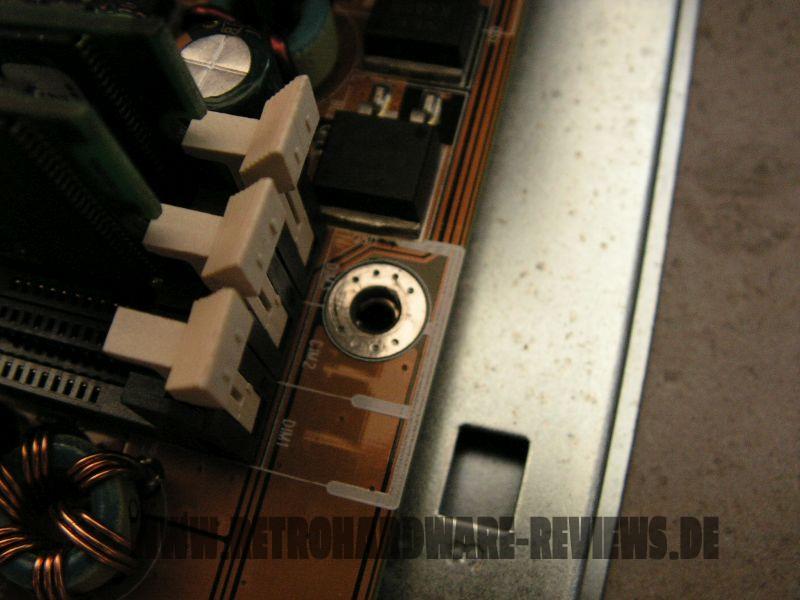
The memory slots on the GA-7IXE4 sit pretty tightly above the AGP port, but Gigabyte moved them up as far as possible. Because of that, there is a little more space between them and the videocard than on many other motherboards, which creates just enough room to let you install and remove memory sticks without the need to remove the graphics card.

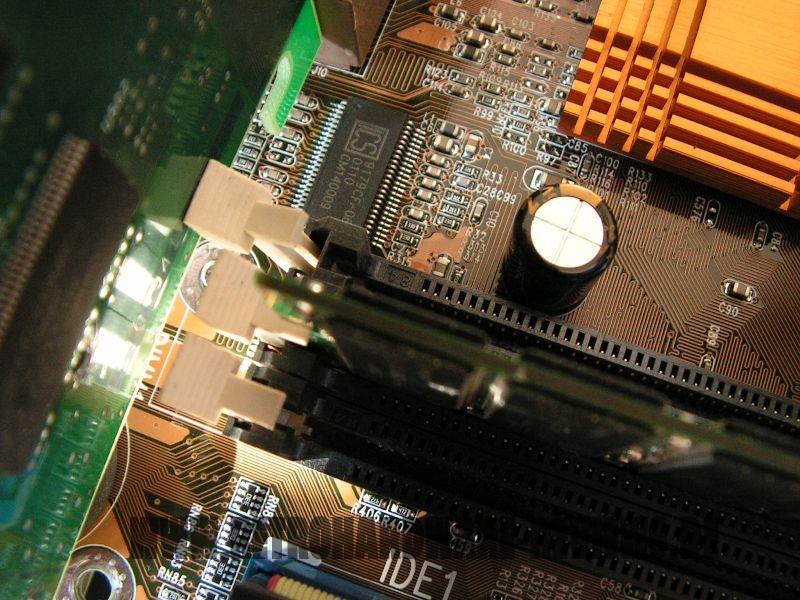
The only real problem can be the position of the CPU socket. Gigabyte has placed it extremely close to the top edge of the board, which can be an issue when using big coolers like the Alpha PAL 8045, as they reach over the PCB. Depending on how close your PSU is to the motherboard, those coolers might not fit, as they would collide with it. Furthermore, it is very likely that the CPU cooler will need to be installed before the motherboard goes into the case.
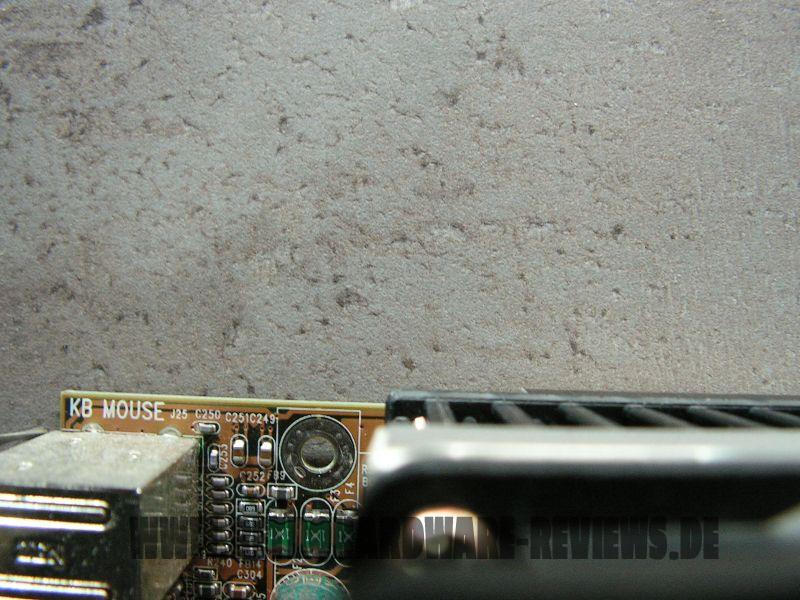

Another thing to mention is, that if a cooler with a through-hole mounting mechanism is used, you have to be really careful during the installation, since there are many SMD parts very close to the mounting holes.


I tested the following seven coolers regarding compatibility and all of them installed without a problem, at least in terms of space around the CPU socket:
- Thermaltake Silent Boost K7
- Cooler Master HHC-001
- Swiftech MCX 370
- Alpha PAL 6035
- Alpha PAL 8045
- Smartcooler 60mm
- Arctic Cooling Copper Lite

The Alpha 8045, as mentioned, slightly extends beyond the PCB, which might be an issue depending on the in-case situation. Thermaltake's Silent Boost K7 closes tightly with the Edge of the PCB, which could also be troublesome in very tight builds.
The lever of the Cooler Master HHC-001's mounting mechanism, however, reaches over quite a bit, which will probably be an issue in most systems. All other coolers fit well in every respect.
The CMOS battery socket is located at the right side close to the edge, so replacing the battery can be be done without the need to remove anything.
All jumper and DIP switch settings as well as connectors are documented well directly on the PCB, so there is no need to look into the manual when assembling the system.
The GA-7IXE4 features two 3-pin fan connectors apart from the CPU fan connector, which are both located at the right side of the PCB. One sits in the lower right corner, which is fine for connecting a front fan. The other, however, is placed in the upper right corner. So, if you want to connect a fan in the rear of the system, its cable has quite some distance to travel.
Test-System and Parts
Baseline Setup:
- CPU: AMD Athlon Thunderbird 1200B (FSB100)
Because I want to compare 1st Gen Socket A mainboards to their DDR follow-ups I have to use a CPU, which is available in FSB100 and FSB133 versions with the same clockspeed. Since I sadly don't have a Thunderbird 1400 B at my disposal, I will use the Thunderbird 1200 for my reviews and comparisons of these boards, which I have in the “B” (FSB100) and “C” (FSB133) version.
- RAM: 1x Infineon 256 MB PC133 CL2 + 1x Infineon 256MB PC133 CL3 SD-RAM sticks
Since the GA-7IXE4 only supports memory sticks up to 256 MB in size, I run 2 sticks of 256 MB together instead of a single 512 MB module. In PC100, both accept the tightest memory timings.
- VGA: MSI Geforce 4 TI4200-VTD8X
To remove any GPU bottleneck for testing, I chose a Geforce 4 Ti as the primary graphics card for my test setups. The Geforce 4 Ti series are also known to pull a lot of power from the AGP port, so that possible problems in that department can also be revealed. It is also somewhat period correct and a good match for a high performance retro-machine that should be able to run late Windows 98SE games without any issues.
- VGA2: 3dfx Voodoo 5 5500 AGP
Many people consider the Voodoo 5 5500 the perfect card for (Win9x-) retro gaming. The Voodoo 5 benefits from a beefy setup, so a powerful Athlon Thunderbird or early Athlon XP is the perfect match for this card.
- Audio: Creative Soundblaster Live! (SB0060)
Creative's Soundblaster Live! can be found in many retro-machines. It offers great sound, perfect Win98SE compatibility and is still widely available for reasonable money. It was also known to cause problems with VIA-based 686B southbridges using old BIOS revisions and VIA chipset drivers. All this should be history at this point, but double checking on pontentially affected mainboards is still not a bad thing to do.
- LAN: 3Com Etherlink XL PCI
Just a good, reliable choice for networking. All legacy Windows versions all the way up from Win95 have built-in drivers for it, which is also a huge “plus”.
- HDD: Western Digital WD200BB (20GB 7200RPM)
No special intention behind this drive, it is just “there” and still works fine.
Additional Hardware for certain Tests:
- Silicon Image Sil3512 SATA Controller & Samsung PM871 128GB SSD
These two will help me measure the PCI bandwidth.
- Hitachi Deskstar T7K500 (500GB 7200RPM)
This drive will tell us, how big we can go with the onboard IDE connectors and how the performance is like.
- 2x Voodoo 2 12MB (SLI)
A pair of Voodoo 2s is a must have for any retro-machine, that doesn't feature a 3dfx card as the primary VGA solution. They offer compatibility to older Glide games and can be used with any more powerful primary graphics card. It is an important thing to know, how well these perform and if there are differences between all the available Socket A chipsets of that era or even between boards using the same chipset.
Drivers used:
- Chipset: AMD Integrated Driver 1.30
- Geforce 4: nVidia Forceware 43.45
- Voodoo 5: Amigamerlin 2.9
- Voodoo 2: FastVoodoo 4.6
- SB Live!: Some driver from my archive, not shure 😉
- 3Com NIC: Windows 98SE preloaded driver
- SATA Controller: Some driver from my archive, not shure 😉
System Setup and Usage
Setting up the GA-7IXE4 was all smooth sailing. I understand why it is said to be a rocksolid board - everthing just worked, it was a pleasure doing my tests and benchmarks with it.
But before I did this, I had to find out where to install all the expansion cards to ensure minimum IRQ sharing. The manual does contain any information on that topic, so I determined the sharing between onboard devices and expansion slots by installing my 3Com NIC into one PCI slot after the other, taking notes on which IRQ got assigned to all listed devices in the POST summary screen.
This is the result:
- PCI #1: shared with USB controller
- PCI #2: no sharing, free INT line
- PCI #3: shared with AGP
- PCI #4: shared with PCI #5, free INT line
Having PCI #3 shared with the AGP port is a rather bad design decision in my opinion. On most motherboards, the AGP port and PCI #1 share an INT line, as you would normally want PCI #1 to be left free anyway, so the graphics card has enough space to breathe.
Based on the information I gathered, I installed the expansion cards as follows:
- PCI #1: SATA controller
- PCI #2: SB Live!
- PCI #3: Voodoo 2
- PCI #4: Voodoo 2
- PCI #5: 3Com NIC
I left the SATA controller out of the system except for the single test it was needed for, to ensure the graphics card isn't affected in its cooling performance. As mentioned in the beginning, all installations and tests went trouble-free. But I want to point out two peculiarities about the AMD750 in general, which also apply to this board:
The AGP signal is known to be very noisy on the Irongate chipset. This is especially the case on early revisions of the chipset, as found on some Slot A motherboards but a “general feature” of the AMD 750. Some videocard drivers automatically limit the AGP speed to 1x on an Irongate-based motherboard, as is the case with the nVidia driver used during testing.
I forced the AGP speed to 2x via Riva Tuner, but it barely made a difference. The AGP speed is just not very good on this chipset, as the benchmarks will show. But I did not experience any instabilities during my benchmarks.
The second thing is by far not this widely known. Despite having a very good PCI bandwith, the Irongate chipset make Voodoo 2 cards (at least in SLI operation; I never tested a single Voodoo 2 on it) perform poorly, at least in D3D applications. Glide and OpenGL games run fine however. I have no explanation for this, but I experienced this behaviour already on Irongate-based Slot A motherboards, too.
In the storage department, the GA-7IXE4 shows its age. The 500 GB hard disk gets detected with a size of 137 GB in the BIOS, which is the maximum support size for this board. In Windows, however, the drive shows up with the full size of 500 GB and thankfully also let me complete the HDTach benchmark so that we can see, how much performance we can expect of the onboard IDE ports. Regardless of this little “victory”, I can not recommend using a hard drive larger than 120 GB connected to the onboard IDE controller - the data written to it will most likely get corrupted.

Size reported by the BIOS

Size reported in Windows
Benchmarks
Synthetic Measurements
Before we get into the 3DMark and gaming benchmarks, let's have a look at some theoretical numbers. These synthetic tests will exhibit the differences between the several chipsets and boards better than any game benchmark and provide us with "background information" that might be of use in understanding the timedemo results later.
Memory Performance: AIDA64 Cache & Memory Benchmark


The GA-7IXE4 ranks last in both benches. While the difference to the 8KTA2 is not that big in terms of memory bandwidth, the memory latency of the Gigabyte board is by far the worst of all boards.
Application Performance: 7-Zip
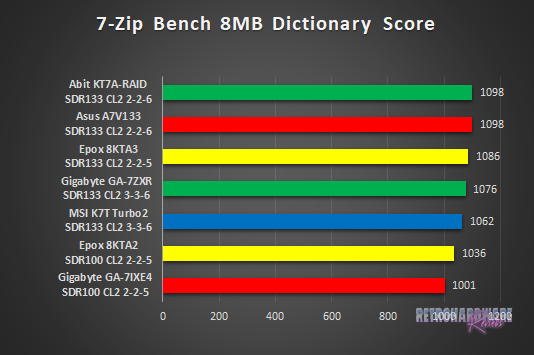
Another last place for the GA-7IXE4.
AGP Performance: Final Reality Benchmark
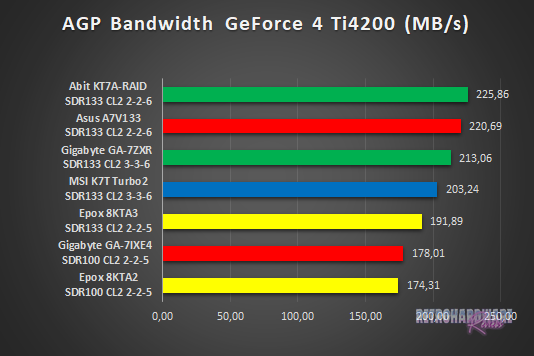

The AMD750 chipset is known for its rather poor AGP performance and it shows in this test. With the GeForce 4 Ti, it ranks second to last, less than 4 MB/s ahead of the EpoX 8KTA2 on seventh place.
With the (more period-correct) 3dfx card installed, performance is a bit closer to the top-performing boards, but it still only ranks fifth.
AGP and PCI Performance: 3DMark 2000 and ATTO
3DMark 2000 as a whole is very focused on TnL and is by far not as interesting for retro-hardware comparisons as its predecessor. Its “High Polygon Count, 1 Light” test, however, is another good way to measure the AGP performance. In opposite to the Final Reality test, the general system performance is also somewhat of importance. The benchmark was executed with the Geforce 4 Ti installed.
To measure PCI performance, I installed a Windows 98SE compatible SATA controller with a Samsung PM871 128GB SSD connected into the system. For the bench, I chose 1024 to 4096 KB block size and picked the overall best values for the read and write throughput. This test will show, which maximum performance can be expected with fast storage options like SATA or SCSI and maybe gives a hint, if the chipset might be good for Voodoo 2 cards.

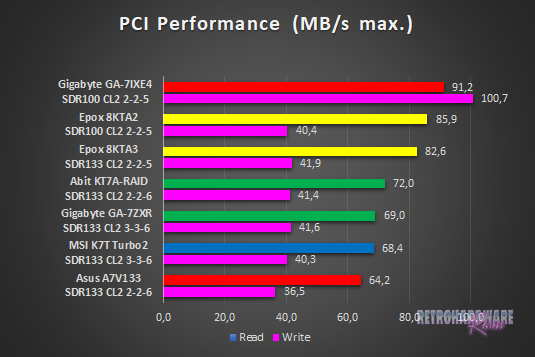
In 3DMark2000's sub-test, the Gigabyte board scores a little higher than its direct competitor, the 8KTA2. However, both of them get clearly outperformed by the newer KT133A based boards.
The GA-7IXE4 shows unrivaled PCI performance in ATTO though, achieving the highest read- and write bandwidth by far.
Storage Performance: HDTach
To measure the performance of the board's IDE and (if available) onboard IDE RAID solutions' performance, I benched one of the latest and fastest IDE drives (the Hitachi Deskstar T7K500 500GB) with the HDTach benchmark. I also tried a much more “recent” drive (the Western Digital Blue Edition 500GB), which should be even faster in theory, but the Hitachi drive produced much better results in this test.
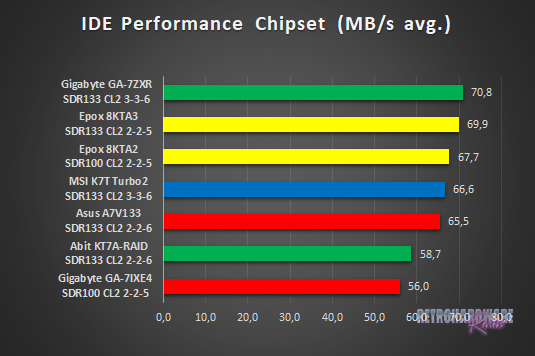
The board doesn't achieve the theoretical maximum of the AMD-756's 66 MB/s (UDMA66) and ranks last with only 56 MB/s.
Gaming Benchmarks
Now that we got all the theoretical performance numbers, let's see how the contenders perform in 3D gaming benchmarks.
3D Performance: 3DMark99max
3DMark99max was released in early 1999 and comes without support for Hardware TnL. The maximum supported (hardware-) DirectX level is DX6. It is a great benchmark to reveal good overall system performance, as it rewards good memory bandwidth and latency more than the slight clockspeed advantage, that some boards have because of their factory-overclocked FSBs.
- Version: "latest"
- Settings: standard


The GA-7IXE4 is far behind the field of contenders in both tests, the difference to the respective top scoring boards is massive.
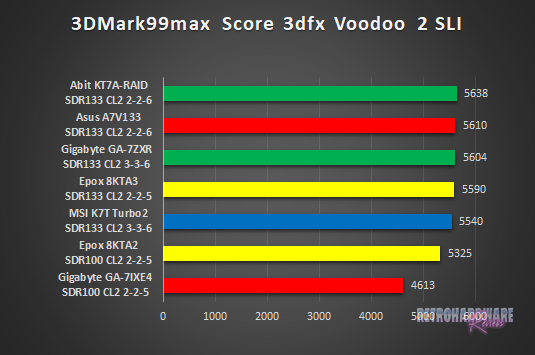
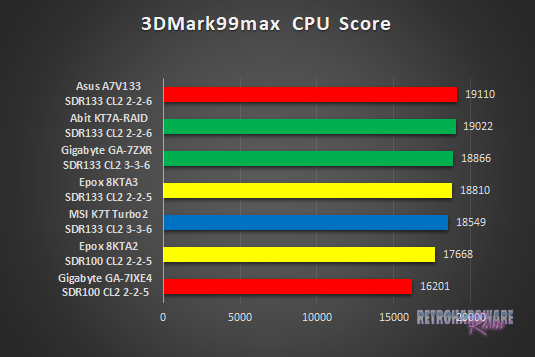
These two tests look even worse for the Gigabyte board, as the EpoX 8KTA2, as the second FSB100-only board in the test, is not completely outclassed by the newer VIA KT133A-based boards. This is a different story for the GA-7IXE4 - its old AMD750 chipset really wasn't prepared to fully exploit the potential of AMD's Socket A CPUs.
3D Performance: Unreal Tournament (UT99) Timedemo(s)
Unreal Tournament (UT99) was released in November 1999 and is notorious for its hunger for CPU power. I chose to use two different timedemos for comparison, of which the utbench.dem timedemo is heavily CPU bound and therefore qualifies to measure the general performance of the boards. The second timedemo benchmark.dem is as GPU limited as possible in this game. This will reveal, how much impact a faster board can still have in more GPU limited situations. This game is also perfect to show, on which chipsets and boards Voodoo 2 cards run best.
- Version: 4.36
- Settings: High, Min desired Framerate "0", Show Decals [x], Use Dynamic Lightning [x]
- Geforce: D3D
- Voodoo 2 and Voodoo 5: Glide


The difference to the 8KTA2 is not that big in the GeForce 4 Ti runs of the UT timedemos. The Gigabyte board is again the slowest, but at least wins over the EpoX board in terms of minimum FPS in the utbench timedemo.
However, the performance gap to the boards using VIAs FSB133 chipset is clearly visible for both FSB100-only boards.


The Voodoo 5 performance looks a bit better in comparison on the GA-7IXE4. While the situation in the CPU-heavy utbench timedemo is about the same, the Gigabyte performs a lot closer to the other boards in the second timedemo. The slim and CPU-efficient 3dfx Glide API certainly helps here.
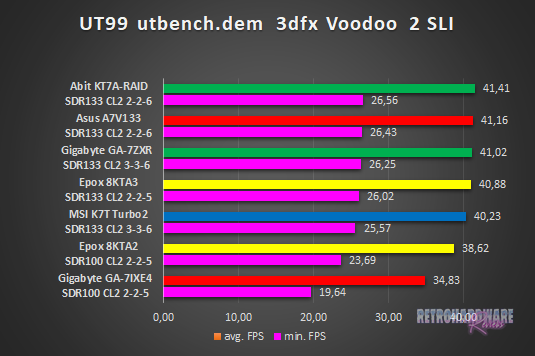
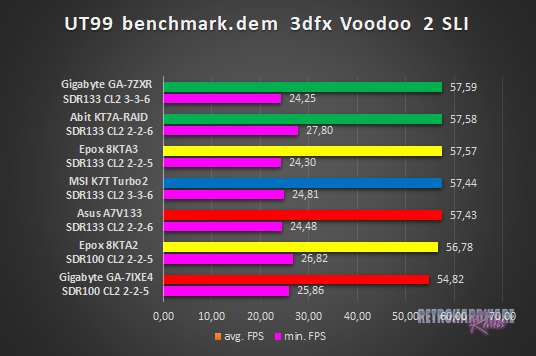
The board's performance in the utbench timedemo is by far the lowest, especially the minimum FPS are noteably lower than even the board right ahead of it.
The opposite is the case in the benchmark.dem timedemo, at least as far as the minimum framerate is concerned, which is one of the best of all boards. Its average FPS are not much lower than those of the other contenders as well.
3D Performance: Quake III Arena Timedemo
Quake 3 Arena was released shortly after Unreal Tournament, in December of 1999. It is known to reward fast memory latency and with its normal preset, it is completely CPU limited; at least for the GeForce 4 and the Voodoo 5. The Voodoo 2 SLI cards clearly limit the Athlon 1200 here, as the timedemo will show.
- Version: 1.32
- Settings: “Normal” Preset, only resolution changed to 1024x768x16
- Geforce 5 and Voodoo5: OpenGL
- Voodoo 2: “Voodoo” Renderer (miniGL)

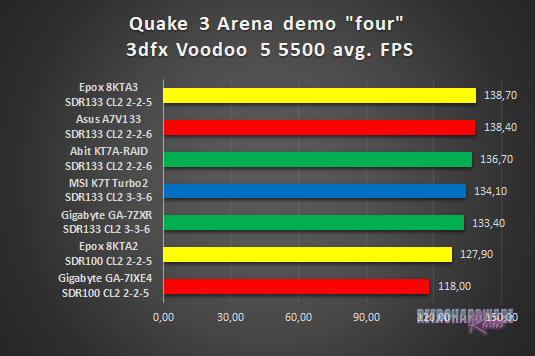
The GA-7IXE4 clearly trails all other boards, which was to be expected after the high memory latency we saw in the first AIDA benchmark and the overall performance shown in 3DMark99max and UT.

The Voodoo 2 SLI setup clearly limits here. All boards score the same FPS, with only the Gigabyte GA-7IXE4 being a close 0,2 FPS behind.
Summary & Rating
Gigabyte GA-7IXE4 (AMD750)
-
Layout
-
Features
-
Overclocking Options
-
Compatibility
-
Documentation & Support
-
Performance: GeForce 4 Ti 4200
-
Performance: Voodoo 5 5500
-
Performance: Voodoo 2 SLI
OVERALL
| Pros | Cons |
| + Great layout | – Limited to FSB100 |
| + 2 ISA slots | – Limited to 768 MB RAM (max. 256 MB modules) |
| + Fantastic PCI performance | – Limited to UDMA66 and 137 GB HDD size |
| + Very stable | – Poor overall performance |





